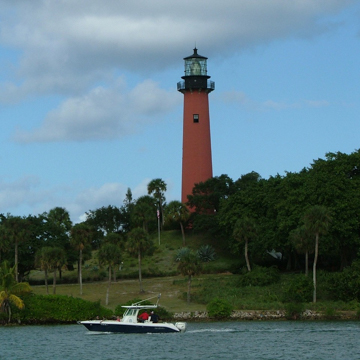The Jupiter Inlet Lighthouse marks the point where the Loxahatchee River empties into Jupiter Sound. It was one of a series of lighthouses erected on Florida’s Atlantic coast between the 1850s and 1880s in order to improve navigation, and is visible from 24 miles at sea. The lighthouse is the oldest extant structure in Palm Beach County, but archaeological evidence indicates that the site has been inhabited for at least 1,000 years, and for some time it was believed (erroneously) to have been a Native American midden, rather than a natural topographical feature.
Congress authorized construction of Jupiter Inlet Light in 1853, and President Franklin Pierce set aside the 61-acre site the following year. The U.S. Army Corps of Topographical Engineers assigned the project to Lieutenant George Gordon Meade, a West Point graduate and civil engineer who would later lead Union forces in the Battle of Gettysburg during the Civil War. Meade, who was also responsible for five other lighthouses in the state, designed the conical brick tower. While the 1852 report that prompted its construction called for the structure to be 150 feet high, Meade took advantage of the natural elevation of the site to reduce the tower’s height to 90 feet. Meade’s assistant, John N. Nystrem, prepared the drawings, which were submitted for approval in late 1854 or early 1855. At that point, Lieutenant William Raynolds replaced Meade and made several revisions to the design, including increasing its height to 105 feet and adjusting the design and thickness of the brick walls (over 31 inches at the base and 18 inches at the top).
Several issues delayed construction until 1856. Jupiter Inlet’s channel had silted up, and the stagnant water bred mosquitos, leading to an outbreak of malaria that required significant dredging to alleviate. The absence of roads or rail over much of the Florida peninsula meant that the site was accessible only by water, complicating the delivery of materials. Building crews also found themselves subject to attack by Native Americans during the Third Seminole War. Workers finished construction in 1860, and the lantern, with a massive first-order Fresnel lens, was lit on July 10 of that year.
The structure has undergone minor changes since then. Salt water and humidity discolored the brick exterior surfaces of the lighthouse, leading its operators to paint the tower red, which aids in its use as a daymark. The lantern was converted to electricity in 1928. The Coast Guard took over operations in 1939, when that branch of the military assumed the duties of the former civilian lighthouse service, and the lighthouse was automated in 1987.
Since 1994, the Loxahatchee River Historical Society has maintained the lighthouse. It is open to the public for tours.
References
Fryman, Mildred L., “Jupiter Inlet Lighthouse,” Palm Beach County, Florida. National Register of Historic Places Inventory–Nomination Form, 1973. National Park Service, U.S. Department of the Interior, Washington, D.C.














